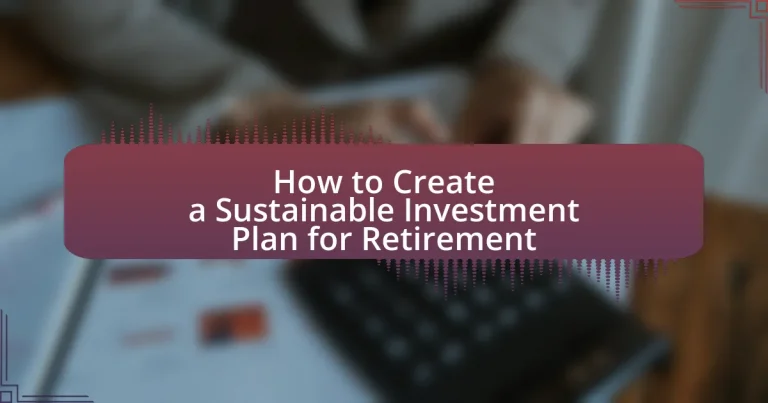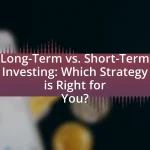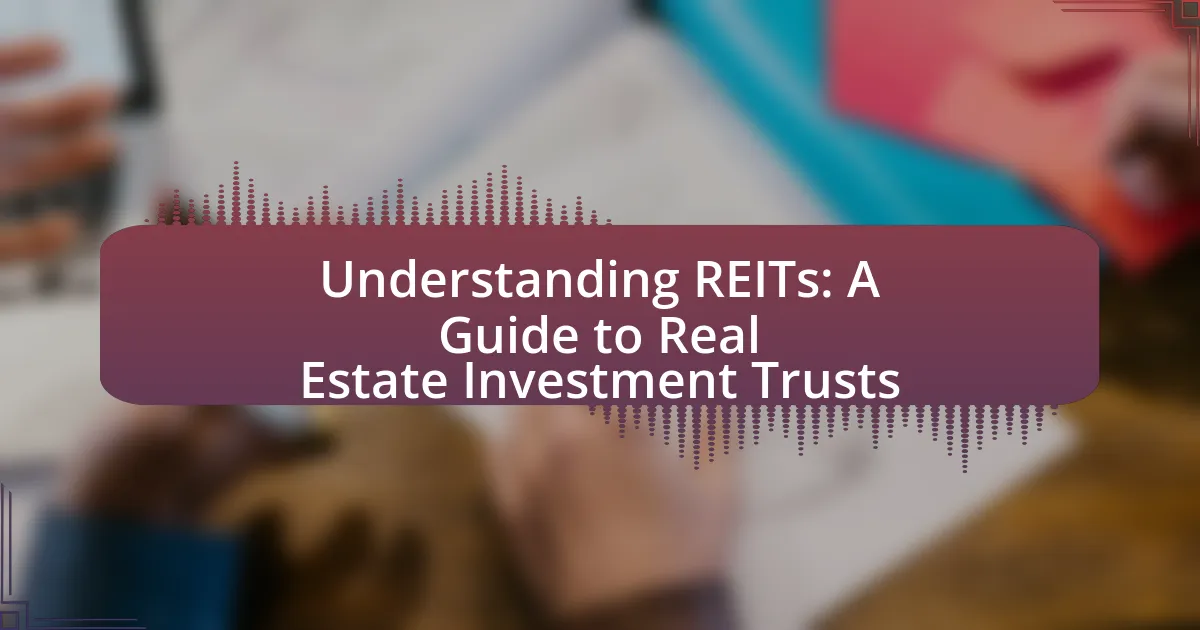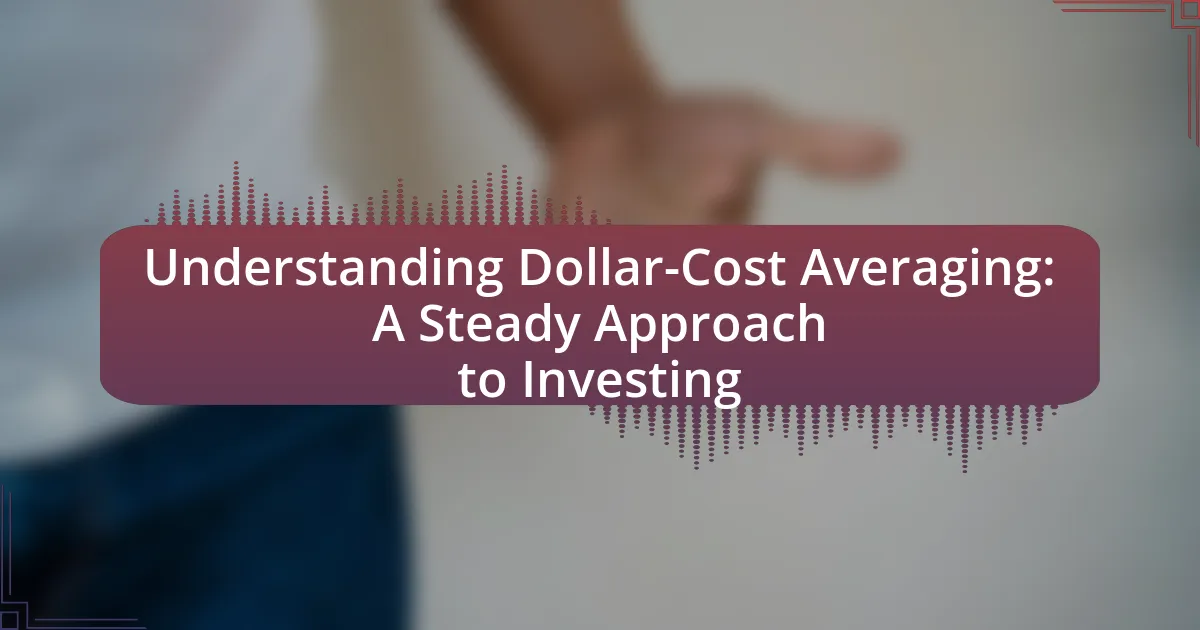A Sustainable Investment Plan for Retirement is a strategy that integrates financial returns with environmental, social, and governance (ESG) criteria, allowing individuals to align their retirement savings with their values. This article outlines the differences between sustainable and traditional investment plans, emphasizing the long-term benefits of sustainable investing, such as enhanced portfolio resilience and potential for higher returns. Key principles of sustainable investing, methods for creating a sustainable investment plan, and tools for assessing financial situations and selecting sustainable options are discussed. Additionally, the article addresses common challenges, misconceptions, and best practices for maintaining a sustainable investment strategy, providing a comprehensive guide for individuals seeking to secure a responsible financial future in retirement.
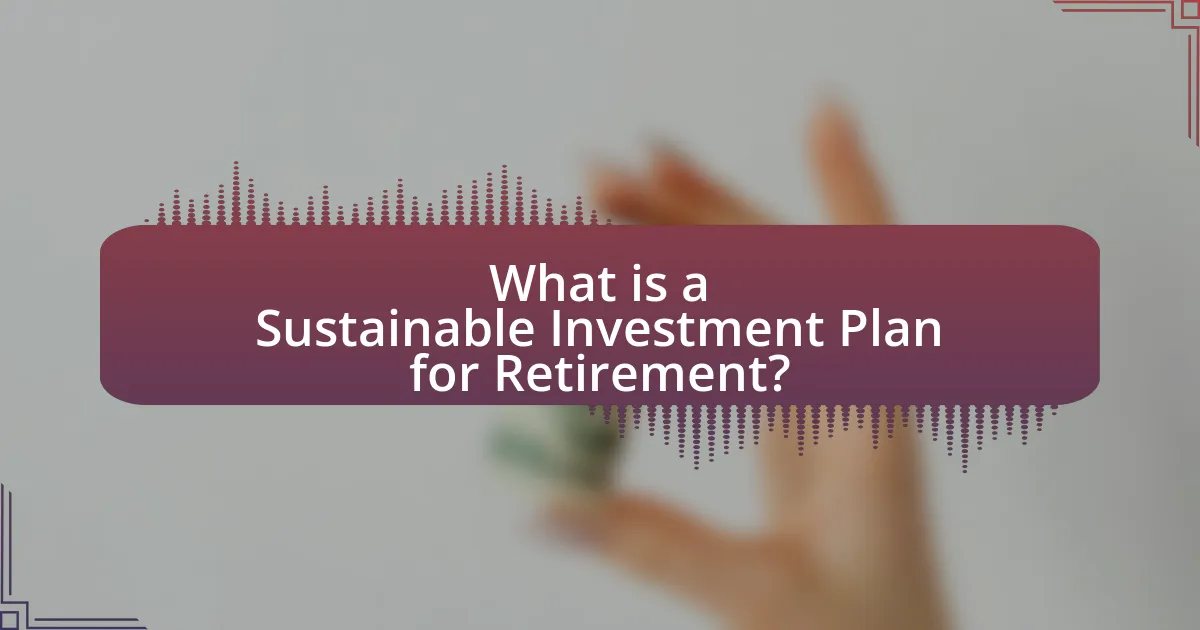
What is a Sustainable Investment Plan for Retirement?
A Sustainable Investment Plan for Retirement is a strategy that focuses on investing in assets that not only provide financial returns but also promote environmental, social, and governance (ESG) criteria. This type of investment plan aims to align an individual’s retirement savings with their values, ensuring that the investments contribute positively to society and the planet. Research indicates that sustainable investments can outperform traditional investments over the long term; for example, a study by Morgan Stanley found that sustainable equity funds outperformed their traditional counterparts by 3.9% annually from 2004 to 2018. This evidence supports the notion that a Sustainable Investment Plan can be both ethically responsible and financially beneficial for retirement.
How does a sustainable investment plan differ from traditional investment plans?
A sustainable investment plan focuses on generating financial returns while also considering environmental, social, and governance (ESG) factors, whereas traditional investment plans primarily prioritize financial returns without necessarily accounting for these broader impacts. Sustainable investment plans often involve selecting companies or projects that promote sustainability, such as renewable energy or social equity, which can lead to long-term benefits and risk mitigation. In contrast, traditional investment plans may invest in industries that contribute to environmental degradation or social inequality, potentially exposing investors to reputational and regulatory risks. Research indicates that sustainable investments can outperform traditional investments over time, as seen in studies by the Morgan Stanley Institute for Sustainable Investing, which found that sustainable equity funds outperformed their traditional counterparts by 4.3% on average from 2004 to 2018.
What are the key principles of sustainable investing?
The key principles of sustainable investing include environmental stewardship, social responsibility, and effective governance. Environmental stewardship focuses on investing in companies that actively reduce their ecological footprint, such as those utilizing renewable energy or sustainable resources. Social responsibility emphasizes investing in businesses that promote social equity, labor rights, and community development. Effective governance involves ensuring that companies adhere to ethical practices, transparency, and accountability in their operations. These principles are supported by the growing trend of investors seeking to align their financial goals with their values, as evidenced by the increase in sustainable investment assets, which reached over $30 trillion globally in 2020, according to the Global Sustainable Investment Alliance.
How do environmental, social, and governance (ESG) factors influence investment decisions?
Environmental, social, and governance (ESG) factors significantly influence investment decisions by guiding investors toward companies that align with their ethical values and sustainability goals. Investors increasingly consider ESG criteria to assess risks and opportunities, as companies with strong ESG practices tend to demonstrate better long-term financial performance. For instance, a study by MSCI found that companies with high ESG ratings outperformed their lower-rated counterparts during market downturns, indicating that ESG factors can mitigate risks. Furthermore, a 2020 report from the Global Sustainable Investment Alliance highlighted that sustainable investments reached $30.7 trillion globally, reflecting a growing trend among investors prioritizing ESG considerations in their portfolios.
Why is it important to have a sustainable investment plan for retirement?
A sustainable investment plan for retirement is crucial because it ensures long-term financial security while aligning with ethical and environmental values. Such a plan typically focuses on investments that not only yield financial returns but also promote social responsibility and environmental stewardship. Research indicates that sustainable investments can outperform traditional investments; for instance, a study by Morgan Stanley found that sustainable equity funds outperformed their traditional counterparts by 3.9% annually from 2004 to 2018. This performance, combined with the growing demand for responsible investing, highlights the importance of having a sustainable investment strategy to secure a stable and responsible financial future in retirement.
What are the long-term benefits of sustainable investing for retirees?
Sustainable investing offers retirees long-term benefits such as enhanced portfolio resilience, potential for higher returns, and alignment with personal values. Research indicates that companies with strong environmental, social, and governance (ESG) practices often outperform their peers financially over time. For instance, a study by Morgan Stanley found that sustainable equity funds outperformed traditional funds by 3.9% annually from 2004 to 2018. Additionally, sustainable investments can mitigate risks associated with climate change and regulatory changes, providing retirees with a more stable income stream. This approach not only supports ethical considerations but also contributes to long-term financial security.
How does sustainable investing align with personal values and ethics?
Sustainable investing aligns with personal values and ethics by allowing individuals to invest in companies and projects that reflect their beliefs about social responsibility, environmental stewardship, and ethical governance. This alignment is evident as investors increasingly prioritize factors such as climate change, human rights, and corporate transparency, which resonate with their moral principles. For instance, a 2021 report from the Global Sustainable Investment Alliance indicated that sustainable investments reached $35.3 trillion globally, demonstrating a significant shift towards investments that not only seek financial returns but also aim to create positive societal impact. This trend illustrates how sustainable investing serves as a vehicle for individuals to express their values and ethics through their financial choices.
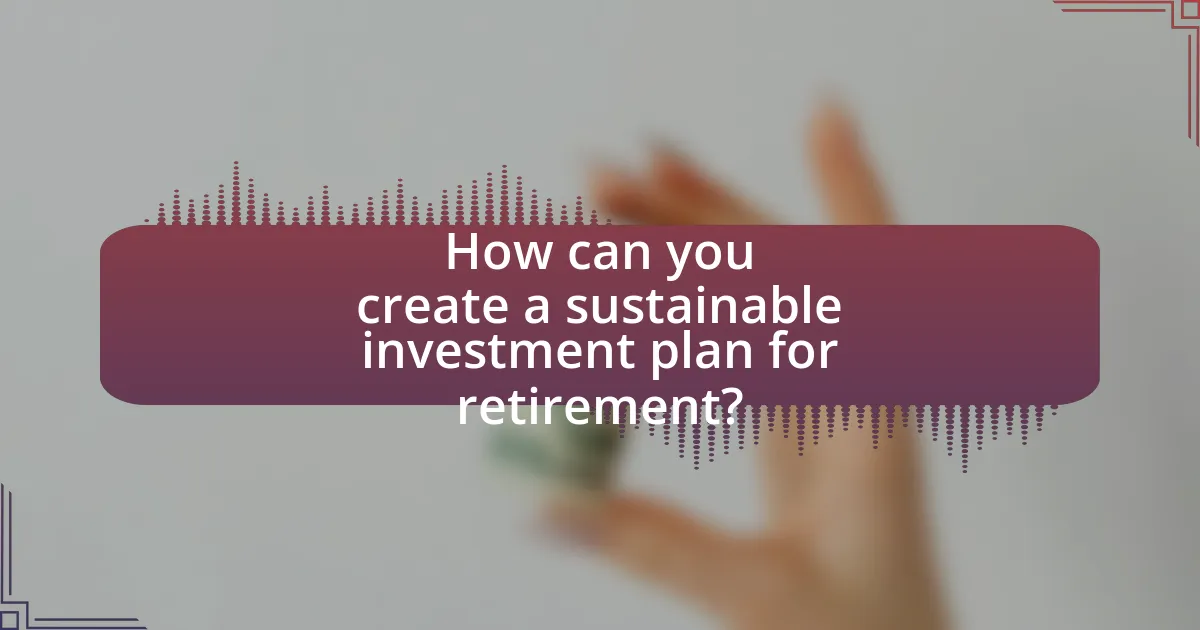
How can you create a sustainable investment plan for retirement?
To create a sustainable investment plan for retirement, begin by assessing your financial goals, risk tolerance, and time horizon. This foundational step allows you to tailor your investment strategy to your specific needs. Next, diversify your portfolio across various asset classes, such as stocks, bonds, and real estate, to mitigate risk and enhance potential returns. Research indicates that a well-diversified portfolio can reduce volatility and improve long-term performance.
Additionally, consider incorporating sustainable investment options, such as ESG (Environmental, Social, and Governance) funds, which have shown to perform comparably or better than traditional investments over time. According to a study by Morgan Stanley, sustainable equity funds outperformed their traditional counterparts by 3.9% annually from 2004 to 2018.
Regularly review and adjust your investment plan to reflect changes in your financial situation and market conditions. This proactive approach ensures that your retirement strategy remains aligned with your goals. Finally, consult with a financial advisor to gain insights and guidance tailored to your unique circumstances, enhancing the effectiveness of your sustainable investment plan.
What steps should you take to assess your current financial situation?
To assess your current financial situation, start by gathering all financial documents, including bank statements, investment accounts, and debt records. This comprehensive collection allows for a clear overview of assets and liabilities. Next, calculate your net worth by subtracting total liabilities from total assets, providing a snapshot of financial health. Additionally, track monthly income and expenses to understand cash flow, which is crucial for budgeting and planning. Finally, evaluate financial goals and compare them against current savings and investment strategies to identify gaps and areas for improvement. This structured approach ensures a thorough assessment, enabling informed decisions for retirement planning.
How do you evaluate your risk tolerance and investment goals?
To evaluate risk tolerance and investment goals, individuals should assess their financial situation, investment knowledge, and emotional response to market fluctuations. This evaluation typically involves a questionnaire that measures risk appetite, time horizon, and financial objectives. Research indicates that understanding one’s risk tolerance can lead to better investment decisions, as evidenced by a study from the CFA Institute, which found that investors who align their portfolios with their risk tolerance are more likely to achieve their financial goals.
What tools can help you analyze your current investments?
Investment analysis tools include portfolio management software, financial analysis platforms, and investment tracking apps. Portfolio management software, such as Morningstar Direct and Personal Capital, allows users to assess asset allocation, performance metrics, and risk exposure. Financial analysis platforms like Bloomberg Terminal provide in-depth market data and analytics, enabling investors to make informed decisions based on real-time information. Investment tracking apps, such as Mint and YNAB, help individuals monitor their investments and expenses, offering insights into overall financial health. These tools collectively enhance the ability to evaluate and optimize investment strategies effectively.
How do you select sustainable investment options?
To select sustainable investment options, investors should evaluate companies based on their environmental, social, and governance (ESG) criteria. This involves analyzing a company’s practices regarding carbon emissions, labor relations, and board diversity, among other factors. Research indicates that companies with strong ESG performance often exhibit lower risk and better long-term financial returns, as evidenced by a 2020 study from the Morgan Stanley Institute for Sustainable Investing, which found that sustainable equity funds outperformed their traditional counterparts by 4.3% annually over a five-year period. By focusing on these criteria, investors can align their portfolios with their values while potentially enhancing financial performance.
What types of sustainable investment vehicles are available?
Sustainable investment vehicles include green bonds, socially responsible mutual funds, exchange-traded funds (ETFs) focused on ESG criteria, and impact investing funds. Green bonds are specifically issued to fund projects with environmental benefits, while socially responsible mutual funds and ETFs invest in companies that meet certain environmental, social, and governance (ESG) standards. Impact investing funds aim to generate measurable social and environmental impact alongside financial returns. These vehicles are increasingly popular as they align financial goals with sustainable practices, reflecting a growing trend in the investment landscape.
How can you research and choose sustainable funds or stocks?
To research and choose sustainable funds or stocks, investors should start by identifying funds that adhere to Environmental, Social, and Governance (ESG) criteria. This can be done by reviewing fund prospectuses, which outline the investment strategy and ESG criteria used for selection. Additionally, utilizing platforms like Morningstar or MSCI can provide ratings and insights on the sustainability of various funds.
Investors should also analyze the fund’s performance history, focusing on both financial returns and sustainability metrics. For example, a study by the Global Sustainable Investment Alliance reported that sustainable investments have outperformed traditional investments over the long term, indicating that sustainability can align with financial goals.
Furthermore, engaging with shareholder advocacy groups or reading reports from organizations like the Forum for Sustainable and Responsible Investment can provide deeper insights into the practices of specific companies within the funds. This comprehensive approach ensures that investors make informed decisions aligned with their sustainability values while also considering financial performance.
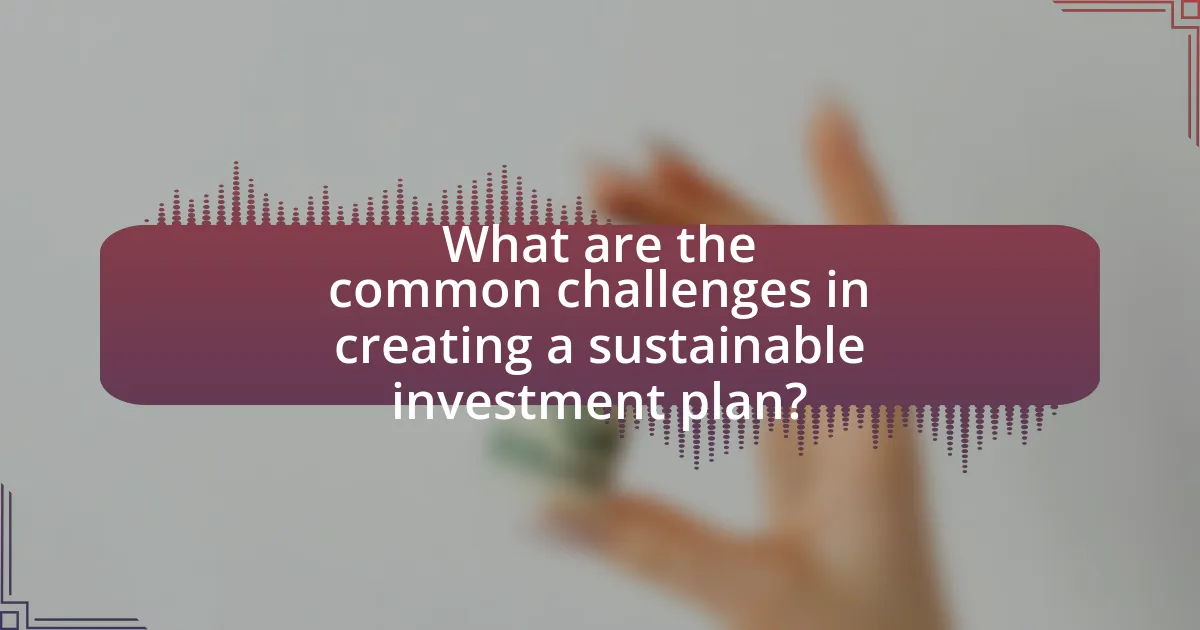
What are the common challenges in creating a sustainable investment plan?
Common challenges in creating a sustainable investment plan include aligning financial goals with environmental, social, and governance (ESG) criteria, assessing the long-term viability of sustainable assets, and navigating the lack of standardized metrics for measuring sustainability. Investors often struggle to balance potential returns with ethical considerations, as sustainable investments may not always yield competitive financial performance compared to traditional options. Additionally, the evolving regulatory landscape can create uncertainty, making it difficult for investors to stay compliant while pursuing sustainability. Research indicates that only 25% of investors feel confident in their understanding of sustainable investing, highlighting the need for better education and resources in this area.
What misconceptions exist about sustainable investing?
One misconception about sustainable investing is that it sacrifices financial returns for ethical considerations. Research by the Global Sustainable Investment Alliance indicates that sustainable investments often perform comparably or better than traditional investments, with studies showing that companies with strong ESG (Environmental, Social, and Governance) practices can lead to lower risks and higher long-term returns. Another misconception is that sustainable investing is only for wealthy individuals; however, a growing number of funds and investment options are accessible to a broader range of investors. Additionally, some believe that sustainable investing is a passing trend, but the increasing regulatory focus and consumer demand for responsible investing suggest it is a lasting shift in the investment landscape.
How can you overcome the perceived lower returns of sustainable investments?
To overcome the perceived lower returns of sustainable investments, investors can focus on the long-term performance and risk mitigation benefits of these investments. Research indicates that sustainable investments often outperform traditional investments over extended periods; for example, a study by Morgan Stanley found that sustainable equity funds outperformed their traditional counterparts by 3.9% annually from 2004 to 2018. Additionally, sustainable investments can reduce risks associated with environmental, social, and governance (ESG) factors, which can lead to more stable returns. By emphasizing these aspects, investors can shift their perspective on sustainable investments from short-term returns to long-term value creation and risk management.
What strategies can help mitigate risks associated with sustainable investing?
Diversification is a key strategy to mitigate risks associated with sustainable investing. By spreading investments across various sectors, asset classes, and geographic regions, investors can reduce the impact of poor performance in any single area. Research indicates that a well-diversified portfolio can lower volatility and enhance returns over time, as evidenced by studies showing that diversified portfolios tend to outperform concentrated ones in the long run. Additionally, conducting thorough due diligence on companies’ environmental, social, and governance (ESG) practices can help identify potential risks and opportunities, further safeguarding investments.
How can you stay informed about sustainable investment trends?
To stay informed about sustainable investment trends, regularly follow reputable financial news sources, industry reports, and academic journals focused on sustainability. For instance, platforms like Bloomberg, Financial Times, and the Global Sustainable Investment Alliance provide up-to-date information and analysis on sustainable investment practices. Additionally, subscribing to newsletters from organizations such as the Principles for Responsible Investment (PRI) can offer insights into emerging trends and best practices. Engaging with online communities and attending webinars or conferences dedicated to sustainable finance can further enhance understanding and awareness of current developments in the field.
What resources are available for ongoing education in sustainable investing?
Resources available for ongoing education in sustainable investing include online courses, webinars, and certification programs. Institutions such as the CFA Institute offer a Certificate in ESG Investing, which provides comprehensive knowledge on integrating environmental, social, and governance factors into investment analysis. Additionally, platforms like Coursera and edX feature courses from universities that cover sustainable finance and responsible investing. The Global Sustainable Investment Alliance publishes reports and guidelines that serve as valuable educational tools for investors. Furthermore, organizations like the Principles for Responsible Investment provide resources and training materials to enhance understanding of sustainable investment practices.
How can you network with other sustainable investors for insights?
To network with other sustainable investors for insights, actively participate in industry conferences and forums focused on sustainable investing. Engaging in these events allows investors to connect with like-minded individuals, share experiences, and gain valuable knowledge about trends and strategies in sustainable finance. For instance, the Global Impact Investing Network (GIIN) hosts events that facilitate networking among sustainable investors, providing a platform for collaboration and information exchange. Additionally, joining online communities and social media groups dedicated to sustainable investing can further enhance networking opportunities, enabling investors to discuss insights and best practices in real-time.
What are the best practices for maintaining your sustainable investment plan?
The best practices for maintaining your sustainable investment plan include regularly reviewing your portfolio, staying informed about sustainability trends, and rebalancing your investments as needed. Regular portfolio reviews ensure that your investments align with your sustainability goals and risk tolerance, while staying informed about trends helps you identify new opportunities and risks in the sustainable investment landscape. Rebalancing your investments periodically is essential to maintain your desired asset allocation and to respond to market changes, which can affect the performance of sustainable assets.
How often should you review and adjust your investment portfolio?
You should review and adjust your investment portfolio at least annually. This frequency allows you to assess your investment performance, align your portfolio with your financial goals, and respond to changes in market conditions or personal circumstances. According to a study by Vanguard, regular portfolio reviews can enhance investment outcomes by ensuring that asset allocations remain consistent with risk tolerance and investment objectives.
What indicators should you monitor to ensure your investments remain sustainable?
To ensure your investments remain sustainable, monitor environmental, social, and governance (ESG) indicators. ESG indicators provide a framework for assessing the sustainability and ethical impact of investments. For example, tracking carbon emissions and energy efficiency can indicate a company’s environmental responsibility, while evaluating labor practices and community engagement reflects social responsibility. Governance indicators, such as board diversity and executive compensation, help assess the management quality of a company. Research shows that companies with strong ESG performance often exhibit better financial performance and lower risk, making them more sustainable investment choices.
What practical tips can help you successfully implement a sustainable investment plan?
To successfully implement a sustainable investment plan, start by defining clear sustainability goals that align with your values and financial objectives. This involves researching and selecting investments that prioritize environmental, social, and governance (ESG) criteria, which have been shown to outperform traditional investments over the long term. For instance, a study by Morgan Stanley found that sustainable equity funds outperformed their traditional counterparts by 3.9% in 2020. Additionally, regularly reviewing and adjusting your portfolio to ensure it remains aligned with your sustainability goals is crucial, as market conditions and personal circumstances can change. Engaging with a financial advisor who specializes in sustainable investing can also provide valuable insights and help tailor your investment strategy effectively.
